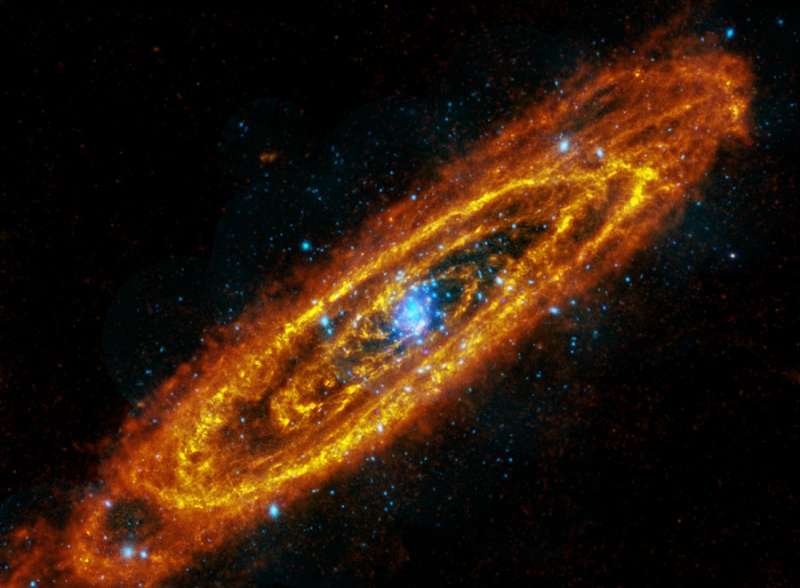Credit & Copyright:
Credit and Copyright: ESA/Herschel/ PACS/SPIRE/J.Fritz(U.Gent) / XMM-Newton/EPIC/W.Pietsch(MPE)
Explanation:
The big, beautiful Andromeda Galaxy,
aka M31, is a spiral galaxy a
mere 2.5 million light-years away.
Two space-based observatories have combined to produce
this intriguing composite image of Andromeda,
at wavelengths outside the
visible spectrum.
The remarkable view
follows the locations of this galaxy's
once and future stars.
In reddish hues, image data from the large
Herschel infrared
observatory traces enormous lanes of dust,
warmed by stars, sweeping along Andromeda's spiral arms.
The dust, in conjunction with the galaxy's interstellar gas,
comprises the raw material for future
star formation.
X-ray data from the XMM-Newton
observatory in blue
pinpoint Andromeda's X-ray binary
star systems.
These systems likely contain neutron stars or stellar mass
black holes that represent final stages in stellar evolution.
More than twice the size of our own Milky Way,
the Andromeda Galaxy is over 200,000 light-years across.
Credit and Copyright: ESA/Herschel/ PACS/SPIRE/J.Fritz(U.Gent) / XMM-Newton/EPIC/W.Pietsch(MPE)
1998 1999 2000 2001 2002 2003 2004 2005 2006 2007 2008 2009 2010 2011 2012 2013 2014 2015 2016 2017 2018 2019 2020 2021 2022 2023 2024 |
Январь Февраль Март Апрель Май Июнь Июль Август Сентябрь Октябрь Ноябрь Декабрь |
NASA Web Site Statements, Warnings, and Disclaimers
NASA Official: Jay Norris. Specific rights apply.
A service of: LHEA at NASA / GSFC
& Michigan Tech. U.
|
Публикации с ключевыми словами:
M 31 - Andromeda galaxy - infrared - X-ray - stellar evolution - Туманность Андромеды - инфракрасные наблюдения - рентгеновские наблюдения - Эволюция звезд
Публикации со словами: M 31 - Andromeda galaxy - infrared - X-ray - stellar evolution - Туманность Андромеды - инфракрасные наблюдения - рентгеновские наблюдения - Эволюция звезд | |
См. также:
Все публикации на ту же тему >> | |
